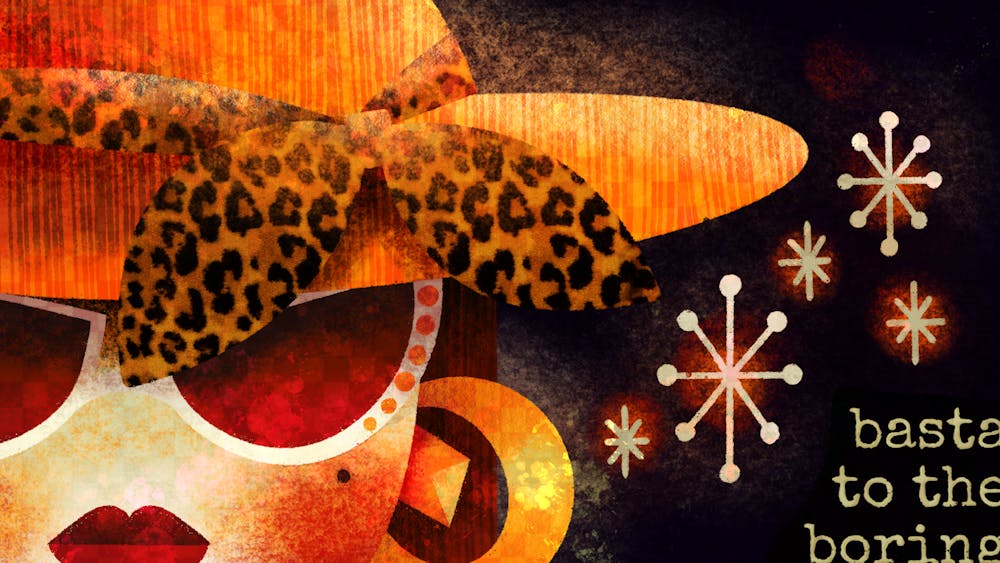The motto of each new year is, out with the old and in with the new. For TikTok though, every month re–enters the perpetual cycle of labeling pre–existing trends as the newest ‘aesthetic’.
This month’s pick: the mob wife aesthetic.
Decked out in fur (faux or not), gold, and leather, all topped off with a smokey makeup look and a teased messy updo, the mob wife aesthetic is all about being over the top. It is associated with Italian fashion houses like Dolce & Gabbana, Versace, and Gucci. But this extravagance is not necessarily tied to a price tag. Instead, Tiktoker Kayla Trivieri explains that it is about having a certain aura. A mob wife is dressed for business. She is confident and self-assured because she knows more about how the world works. She is always busy with places to go and people to see.
Dua Lipa is one of many celebrities that have emulated the mob wife aesthetic. Back in November, the singer stepped out in New York in a sheer dress, long leather boots, and a massively oversized black fur coat. It looked straight out of The Godfather.
The mob wife aesthetic is a direct contrast to the trends of 2023—Barbie core, coquette core, soft-girl core, which sometimes saw the infantilization of women. As fashion critic Emilia Petrarca points outs, “It’s right there in the name: she’s a wife! She’s not a girl; she’s a woman.” However, even if the mob wife aesthetic is intended a rebellious response that aims to empower women, you can’t help but notice a mob wife’s identity is still tied to a man—her husband.
The TikTok trend first emerged in October of last year, with Sarah Acuri (theSweetPaisana) showing us how to dress like a mob wife, that is the wife of an Italian mafia boss. But the aesthetic blew up in the new year when Mikayla Toninato posted a TikTok, declaring that “clean girl is out, mob wife is in.” Some have conspired that the aesthetic’s emergence was made to coincide with the HBO show Sopranos’ 25–year anniversary. Toninato, however, explained she had never even heard about the Sopranos.
The aesthetic, however, has been accused by some of glorifying organized crime and appropriating the culture of Italian Americans. Some Italian Americans on TikTok have complained that people wear the aesthetic without giving them credit when they have been dressing this way for a long time. It is reminiscent of a similar debate around the clean–girl aesthetic being appropriated from Latin women. A form of fashion once considered tacky once again has suddenly become all the craze. It’s hard not to notice how one's race can affect the trendiness of an outfit. It seems time and time again on TikTok, ‘aesthetics’ find themselves closely tied to appropriation.
Acuri has responded to some of these critiques of the mob wife aesthetic. She explains that we are simply in an era where everything is labelled; ten years ago, this style may have been called "80s bold glamour" instead of the "mob wife aesthetic." This makes sense since fashion goes in cycles, and I can't help but notice that the “mob wife” is how my grandmother used to dress.
The thing is, yes, fashion has always gone in cycles, but thanks to TikTok, these cycles seem to be shorter than ever. Every six months, there is a new ‘aesthetic’ deemed most trendy. It feeds into an awful cycle of consumerism and fast fashion. There is a lack of originality when everyone changes their fashion style every few months to accommodate the newest one. It is obviously generalist to say that once a new aesthetic emerges, we all jump on the bandwagon to dress that way.
I, for one, am not a participant in the mob wife aesthetic. However, with the way social media permeates into our everyday lives, these trends are influential enough to cause plenty a lot of people to change up their wardrobes. Just think of all the people you see walking around campus with Stanley cups, Owala water bottles, or Uggs—all a result of social media influence, whether they want to admit it or not. Some argue, the rising popularity of thrifting has helped bring more originality and sustainability into these fashion aesthetics. But this is controversial on its own. Similar as with critiques of the mob wife, people who have been participating in this practice for years concerned with the implication of its newfound trendiness.
While microtrends change often, the overall fashion style is focused on dressing in a way that is put together and classy, rooted in Sofia Richie's concept of 'quiet luxury' that gained popularity last year. This class of fashion trends reflects Gen-Z's newfound adulthood. With the older members of Gen–Z well into their mid–20s, this makes sense.
We are the first generation to properly grow up on social media, with most of us on Instagram early into our teens. The 2010s saw us in our awkward teen phase, dressed in skinny jeans and slapping the craziest filters on all our photos. Then came the Y2K revival to reminisce about our childhoods. Simultaneously, there was the older, more mature, clean–girl aesthetic. Now, with the mob wife aesthetic, it seems we might be finally growing up.

